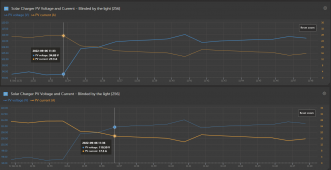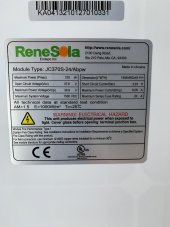NewGuyNoob
New Member
- Joined
- Jul 30, 2021
- Messages
- 86
Ok, Thanks for the information. This is quite useful from a general aspect of Solar. I would like to try to point a few things out and try to get the confusion out of my head.You can't pick and choose ratings:
4000W rating.
18A max input rating.
450V max input rating.
60A output rating.
61V max output limit.
You can't ignore ANY of the above. If ANY hit max, that's all you're going to get.
You can't ignore the power equation, Power = voltage * current, ALWAYS
You can NEVER input more than 18A FROM the array to the MPPT.
You can NEVER output more than 60A FROM the MPPT to the battery bus.
From that you can calculate things:
Power = Voltage * Current
4000W = Voltage * 18A
Input: Voltage = 4000w/18A = 222V thus Array must be at least 222Vmp to hit 4000W INPUT.
Output: Power = 61V * 60A = 3660W
This tells you that you can NEVER get 4000W out of the MPPT because your battery voltage can never output higher than 61V.
Some other considerations.
If the battery data is being reported by the BMS, then it's NET. This would account for the "missing" power. if the values are reported by the EG4, then the "missing" power is from inefficiency.
- Ratings have tolerance. Solar panels themselves are typically ±3%. Any of these numbers may vary by ±1-3% depending on construction quality.
- MPPT are not 100% efficient. This unit is claimed 93% efficient. To get the calculated 3660W max, you'll need AT LEAST 3660/.93 = 3935W of array.
1) I have a bit under a 12 KW [11.8] array going to this SCC:
A single panel is = 370w / Imp =9.28a Vmp=39.9
This is one string, to one SCC: [Current / Existing Growatt configuration]
5s3p = 199 volts x 27.84 amps. (15 x 370w panels). String 1
5s3p = 199 volts x 27.84 amps. (15 x 370w panels). String 2
30 solar panels in total, 2 strings of 199.5v x 27.84 amps.
The maximum input for SCC is 18A per channel, not to exceed 450v. [500v lets the magic smoke out]
SO: --- Current Solar Configuration:
String 1 = 199.5 x 18A = 3,591 watts
String 2 = 199.5 x 18A = 3,591 watts
This Totals = 7,182 watts - deduct ineffeciences perhaps as well.. Very Similar to what I am seeing. This brings up questions from a MPP SCC viewpoint.
If input is being clipped at 18A, however I have quite a bit more power going to each of the MPP SCC @ 27.84 amps.
[Is this the correct way of thinking]
The excess amperage is clipped because I can not go over 18A input? The MPP will not [[[lower/exchange [invert] amperage]]] and exchange it for Voltage up to its maximum?
[Previous Belief, guessing its incorrect]
If I send in minimum voltage say 100v x 50amps, and the MPP converts voltage and amperage for the biggest bang for its buck, so to speak. Of course within the limits of the MPP. In other words I expected the MPP to exchanged excess amperage to make up for the Voltage difference between the two MPP's.
Example:
So lets say I sent 200v x 30a = 6KW. I would expect the MPP to convert amperage to Voltage. This would drop the Amperage to within the MPP's range and increase the voltage = to something it can handle, not exceeding 450v or 18a. But the output would still equal 6KW or its limit, which for each channel that is 4KW as stated in the specification sheet.
I'm viewing the 450v x 18a as the totality for the entire Solar Charge Controller as its stated: 450v x 18a = 8100 watts.
In other words, if i had a single string of 18 amps @ 450v, I would still only see a 4k output as channel [1] of the MPP is limited to a 4KW, or max output of the MPP. So if I brought a total of 2 strings of 8.1 KW as above [450vx18A =16.2KW] to the MPP SCC, I would only get 8KW of power output because both strings would be clipped at 4KW.
How is MPP applied to this particular Use case then?
What is the maximum single string that can be used?
This is actually been brought up and discussed here on the forums as well:
EG4 6500EX-48 - Single input/MPPT max useable PV wattage - question
So this discussion so far means I can not get to an single string that would produce more than what I have. As I am already clipping due to Amperage limits for this string?
If this does not apply to voltage and amperage adjustment from the input string side, then I don't understand MPP's purpose, or the theory I have read I suppose.
@sunshine_eggo statement:
In the picture I posted above, I pretty sure I was at 14 and 15amps, I never hit a max. That is why I was asking about clipping to begin with.You can't ignore ANY of the above. If ANY hit max, that's all you're going to get.
My future plan for my existing solar array:
My plan is to 8s a string for a total of 32 panels:
Each solar String would be: Vmp = 319.2v x 9.28a. This is 2.96KW per String.
A total of 4 strings, 2 to each EG4 6500, that would be just below 6k per SCC, in Split Phase giving me just under 12K solar potential. Would this be a correct understanding?
Thanks for all the reads and replies and discussion.
We should all be so.. dang comfortable!

"Invert and chill"
Also, yeah its a little space heater for sure! HOLY CRAP its loud. Glad I have it out in the PowerShed~!






